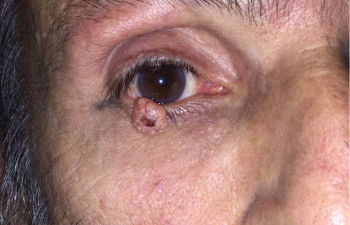
What to Expect Getting a Biopsy on Your Eyelid From Dr. Kian Eftekhari
When we see patients in the Salt Lake City office to evaluate a lesion on the eyelid, there is understandably a lot of anxiety about what it means to get a biopsy. A biopsy? Near the eye? That sounds scary to many people. The purpose of this post is to educate you on what Dr. Eftekhari does to relieve that “fear of the unknown,” and how the process works.
If you have a lesion on your eyelid, Dr. Eftekhari will first see you in the office to determine if it needs a biopsy. Some reason for why would be if it’s growing, or if it looks concerning, or if it’s irritating the eye.
In some cases, Dr. Eftekhari may be able to perform the biopsy the same day in the office either in SLC, Draper or Park City, Utah . We have a multi-tiered system to ensure maximum comfort and minimal pain or discomfort during your procedure. Here is how it will work:
First, our team will take a photo of the spot in question.
Then, we’ll get a consent form to obtain your permission to do the procedure. While not necessary, it is important to stop aspirin or other blood thinners (see Pre-Op instructions for details) if you anticipate needing a biopsy at your office visit. That will help with how much cautery we have to use and also limit your bruising.
Then, we use a topical numbing cream placed on the eyelid skin around the area to help soothe the skin prior to the procedure. We like to let that sit for 5-10 minutes to soak in as we get prepared for your biopsy.
Next, Dr. Eftekhari will come in, clean off the extra numbing cream, and lie the exam chair flat and place a numbing eyedrop in the eye. At this point, you don’t necessarily have to keep your eyes open for any portion of your procedure, you just listen to Dr. Eftekhari’s instructions and try to relax.
Next – and this is our secret sauce 🙂 – we use a device which vibrates on your skin just underneath where Dr. Eftekhari will inject some lidocaine (local anesthesia). Sometimes Dr. Eftekhari uses another medication called articaine which helps especially for lesions located right along the eyelashes. The vibrating soothing device works like this: as it vibrates on your skin, it stimulates receptors called mechanoreceptors which saturate many of your nerves that would sense pain. When it saturates these nerves, there is a lot less bandwidth for your nerves to sense pain or send a signal to your brain because the vibration basically distracts these important nerve endings. While the vibration is occurring, Dr. Eftekhari uses a tiny needle to inject local anesthesia to the site and numb your eyelid for the procedure.
Once the numbing is done, you’re on the downhill portion of the procedure. Dr. Eftekhari will dab a bit of antiseptic on the site, test the area to make sure the numbing medicine is working well, then perform the biopsy. His assistant will help dab the area while he works, and then Dr. Eftekhari will use a small cautery device which helps to kill some of the cells which first created your eyelid lesion. Once that’s complete, we will clean the area and place a dab of antibiotic ointment on the biopsy site. We’ll give you a copy of our biopsy instructions (link here on patient instructions page) and send in a prescription for antibiotic ointment to use for a few days.
After your biopsy, most patients are able to drive themselves home or back to work. If you are nervous about this, bring a driver with you or we can schedule your biopsy for another day.
We often will hear back from our pathology colleagues whether the bump or lesion is anything to be concerned about (a skin cancer, for example) within a week. We’ll call you when we have your results. After your biopsy, you may have a little bruising and swelling, and you will have a small scab at the site of the biopsy. This will usually heal on its own, and feel free to ask Dr. Eftekhari if you have questions about healing.
With clinics in Salt Lake City, Draper & Park City, Eyelid Center of Utah’s Dr. Eftekhari is a board-certified ophthalmologist (ABO profile link) and oculofacial plastic surgeon who exclusively specializes in eyelid surgery, and is an active member of the American Society for Ophthalmic Plastic & Reconstructive Surgery (www.asoprs.org).
Posted on behalf of
